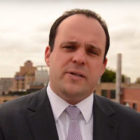
What is the opposite of a faux pas?
Because that is what we have been dealing with ever since Friday. On that day, the Trump administration noted International Holocaust Remembrance Day.
Except, the statement did not mention the Jews.
As someone said on Facebook: “That’s like talking about the Crucifixion, and forgetting to mention Jesus.”
Jews and others complained, loudly. The White House defended their omission, also loudly.
On Monday, press secretary Sean Spicer defended the statement. He mentioned that it was “with the help of an individual who is both Jewish and the descendent of Holocaust survivors.”
And the author is……Trump aide, Boris Epshteyn.
Epshteyn is a Russian-Jewish immigrant and the descendent of Holocaust survivors. Epshteyn was born in 1982 in the former Soviet Union. His college friendship with Trump’s son, Eric, led to his engagement in Trump’s campaign. He emerged as one of his chief attack dogs and reliable talking heads on television.
“Boris takes a certain amount of delight in trying to bully the interviewer,” said Joy Reid, the host of a show on MSNBC, who has clashed with Mr. Epshteyn. “He sees every night as combat and he goes in as very combative.”
So, how is it possible that this Russian-born Jew, with memories of the Holocaust in his own family, could write a statement that utterly relativizes the Holocaust, depriving it of any specific Jewish connection?
I suggest that without even realizing it, Boris Epshteyn internalized the classic Soviet narrative about the Holocaust.
And, in a way that he would find uncanny, Donald Trump has imbibed that narrative as well.
Let us understand utter centrality of the Russian Jewish experience to the Holocaust.
About one-third of all Jews who died in the Holocaust were Soviet citizens.
Between 1.5 million and 2.5 million of Soviet Jews were murdered in the Holocaust and about 200,000 more died in combat.
This amounted to about 10 per cent of all Soviet deaths — at a time when Jews were only 2.5 percent of the total pre-war Soviet population.
And yet, in the Soviet Union, for decades, it was simply forbidden to mention any specific Jewish connection to the Holocaust.
Consider the words of Olga Baranova:
Soviet historians usually viewed that catastrophe as an integral part of a larger phenomenon – the Nazi genocide and the tragedy of all Soviet people (whether Jews, Russians, Belarusians, Ukrainians) occasioned by Nazi racism directed not only at Jews, but also at Slavs who all were targets of the Nazi policy of enslavement and extermination.
Consider what happened at Babi Yar, a ravine outside Kiev, on September 29-30, 1941.
Over the course of two days, German soldiers massacred 33,771 Jews. In the months following the massacre, German authorities stationed at Kiev killed thousands more Jews at Babi Yar, as well as non-Jews including Roma (Gypsies), Communists, and Soviet prisoners of war.
It is estimated that some 100,000 people were murdered at Babi Yar. It was the largest massive shooting during the Holocaust — the prime example of what has been called “the Holocaust by bullets.”
And yet, the very Jewish aspect of that horror was deliberately erased.
Even the fact that September 29-30 just happened to be Yom Kippur.
This inspired the great Russian poet, Yevgeny Yevtushenko, to write his classic poem “Babi Yar,” which drew attention to the atrocity, in 1961.
It was not until 1976, when a memorial was erected at the site to honor the “citizens of Kiev” (note: not the Jews) who were killed there.
It was not until 1991, after the fall of the Soviet Union, that a menorah-shaped monument to the Jewish victims of the Babi Yar massacres was allowed to be erected at the site that is now home to a city park.
The desire to remember the Holocaust was partially responsible for the reclamation of Jewish identity among young Soviet Jews.
To quote Yossi Klein Halevi:
A Zionist underground in the Soviet Union was forming around Holocaust commemoration. It began in the Rumbuli forest near Riga, where thousands of Jews were buried in mass graves. Attempts to mark the site were thwarted by the authorities, and Rumbuli became a place of defiant pilgrimage. Resisting the suppression of Holocaust memory became a catalyst for rebellion against the untenable position of the Soviet Jews, denied any positive Jewish identity but forbidden, because of state and popular anti-Semitism, entirely or smoothly to assimilate.
But, the intellectual damage had been done.
The Soviet method of interpreting the Holocaust — to universalize its meaning — became the dominant leftist mode of memory.
At the Stockholm International Forum on the Holocaust, held in 2000 (which was, at the time, the largest international conference on the Holocaust that had ever been convened), speakers described concentration camp victims as “fellow Europeans.”
Or: as “fellow human beings.”
Or: as “innocent men, women, and children.”
Not: “Jews.”
Now, I do not know Mr. Epshteyn. I do not know about his upbringing, about his Jewish identity, about his affiliations.
I am saying this, however: leaving the Jews out of the story of the Holocaust has an “impressive” Russian history — a history that walks hand in hand with its grim traditions of anti-Semitism.
No matter how and why the White House “omission of the Jews” happened, one thing is for sure.
No one misspoke. It was not a typo.
It was deliberate.
As to what that should tell us, I leave that to you, dear reader, to ponder.
